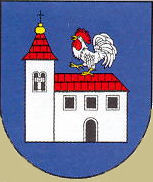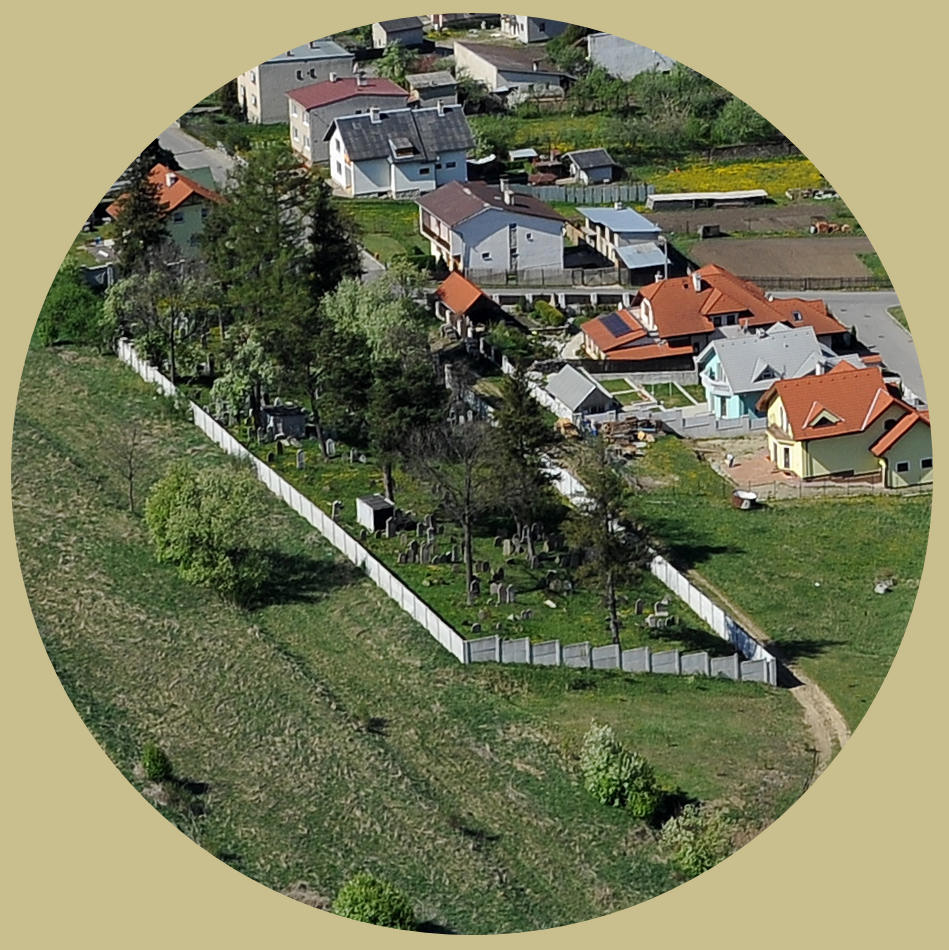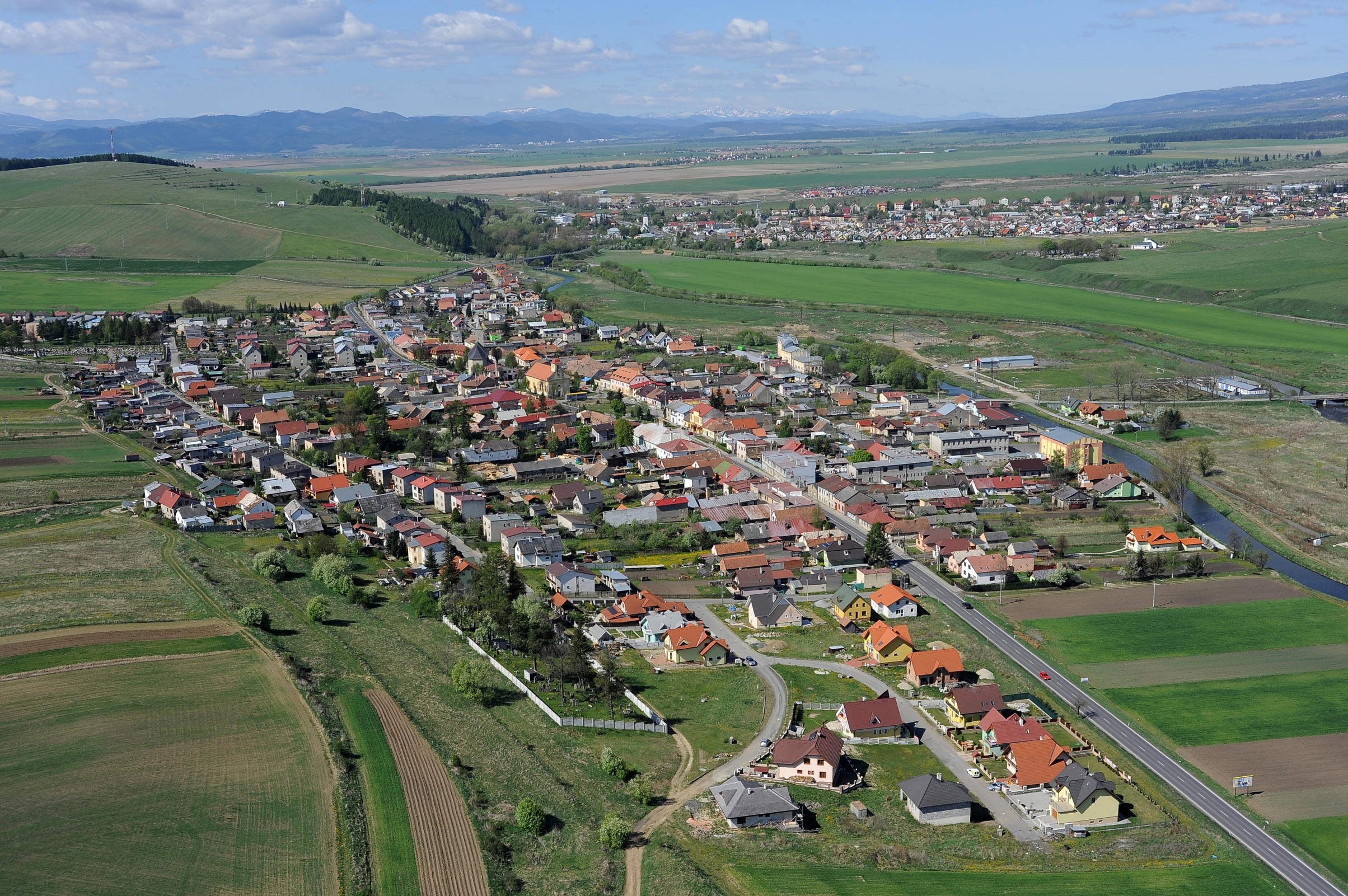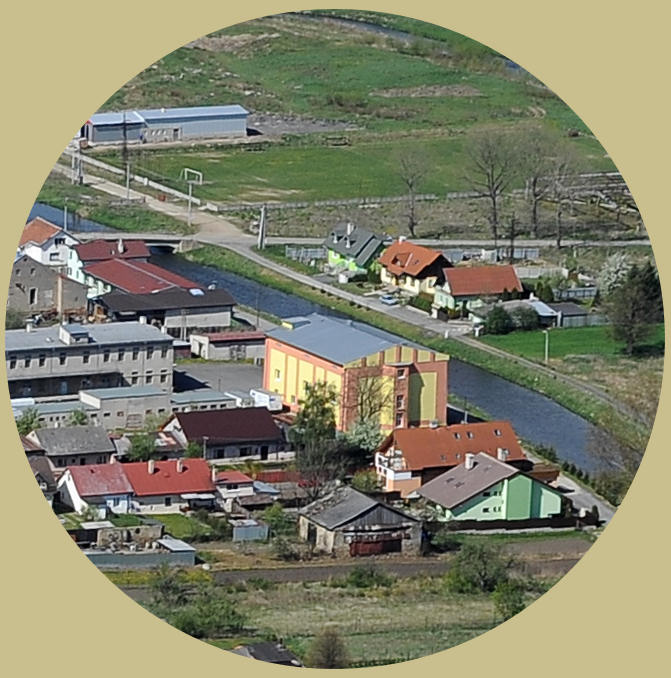|
|
|
|
 |
Huncovce, SlovakiaPronounced "Hoon-sof-say"
|
Hunsdorf (German), Hunfalu (Hungarian), Villa Canis, Hunisvilla (Latin)
(Yiddish) אונסדארף, (Hebrew) הוּנצוֹבצֶה
|
|
|
|
 |
Huncovce, SlovakiaPronounced "Hoon-sof-say"
|
Hunsdorf (German), Hunfalu (Hungarian), Villa Canis, Hunisvilla (Latin)
(Yiddish) אונסדארף, (Hebrew) הוּנצוֹבצֶה

Enlargement of Jewish cemetery |

|

Enlargement of the
former Synagogue |
|
|
Aerial View of Huncovce, ca. 2009 |
|
On this page:
Slovakia lies in the heart of Europe. Using JewishGen's Resource Mapping, you can see that Huncovce is a village and municipality in Kezmarok District in the Presov Region of north Slovakia. Huncovce is so small, that to locate it, just 3 miles WSW of Kezmarok, you need to zoom in on the map. You can see its proximity to Kezmarok -- about one hour's walk away!
Another way to locate it can be seen on this map, from Google Maps, on the road to Poprad, and one third of the way between Kezmarok and Poprad. It is located toward the northeastern border of Slovakia, northeast of Poprad and south of the Polish border, at Latitude 49°7´ N, Longitude 20°23´ E. Its population in the 21st century is 2400 and is located on the Poprad River.
One can find information on the general history of the town of Huncovce from various sources including the internet. Very few sources mention anything about the Jews who once lived there. For an overview of the Jewish perspective, and so as not to repeat the same information, refer to the section on Huncovce, translated from the Hebrew in Pinkas Hakehillot Slovakia. (Note: There are many sections within this book still requiring translation!)
In this KehilaLinks page, the intent is to provide material about the Jewish community in Huncovce that has not yet appeared in English anywhere else. As such, this material has been translated from sources in Hebrew, Yiddish and Slovak.
Among the several books written by Rabbi Leopold GREENWALD, there is Mekorot Lekorot Yisrael, written in Hebrew. Material for that book was originally compiled when, as a young yeshiva boy of 14, in 1903-1904, and under the supervision of his rabbi, Rabbi Samuel ROSENBERG, he took an interest in visiting the old and new cemeteries in Huncovce and copying down the inscriptions of the towns esteemed rabbis. He also pored through Huncovce's kehila archives to glean other relevant information, such as the construction of the synagogue and the rules of order for the members of the kehila. He also took time to talk to the elderly inhabitants and learn from their experience. He returned again to visit Huncovce in 1913 and finish his work, and the Rabbi, remembering what he had done, encouraged him to finish his book. But he did not actually complete this book until 1934. Thanks to this precious book, we have the only exisiting information about the tombstones that are no longer to be found and information to correct other sources. We are also indebted to his son, Mr. Jack "Yankele" Greenwald for his valuable assistance and patience.
The text below was translated and adapted from pages 316-321 in the book written (in Slovak) by Eugen Bárkány (1885-1967) and Ľudovít Dojč (1915-1995), Zidovske Nabozenske Obce Na Slovensku (Jewish Religious Communities in Slovakia), published in Bratislava in 1991. Thanks are due to Miss Monika Jasova, of Kezmarok, Slovakia, for her initial translation from the Slovak into English, and for assistance to this webmaster in editing the text into what follows below.
The following section describes the history of Huncovce as it pertains to the Jews who came to live there in the middle to late 18th century and onward.
The oldest information about Jews and the Jewish community -- once very famous for its yeshiva -- was compiled by university professor Dr. Gyözö Bruckner. In his work The History of the Spis Region, its Contemporary Inhabitants, he states:
“One must include Jews among the youngest inhabitants of the Spis region considering that until the 18th century Jews were not allowed to live within the walls of German towns. However, the landowners permitted Jews to settle in their land and estates provided they pay high fees and taxes. … While in 1728 only two Jewish families lived in Huncovce, by 1735 six families lived here already, and in 1754 the number increased to 31 families…”
In the old cemetery (partially now underwater) close to the Poprad River, where people have not been buried for more than 200 years, there is a tombstone on which the year 1697/1/ could be read. The other two remaining tombstones resembled this oldest tombstone in material, size, shape and style of engraving. From this we could safely conclude that Jews lived in Huncovce even in the 17th century. Peter Ujváry also confirms this. He says that Jews began establishing a community in the beginning of the 17th century with an established religious community by the middle of the century. According to Ujváry the village of Huncovce was a ghetto in the Spis region for a long time because 16 other towns in the Spis didn’t permit Jews to live within their town’s walls.
The first rabbi in Huncovce was Benjamin SINAI who died in 1708 /2/. But the first written records about the development of this religious community toward the end of the 17th century, were written in the middle of the 18th century. One such document is dated 1757. It is a report containing recollections of the second rabbi, Rabbi SUSSKIND, who had been a rabbi in Tarnow before settling in Huncovce. After Susskind, Rabbi Jozef RAPPAPORT became the rabbi. His three-volume work Bigdei Kodesh (Holy Garments) became widespread all over Europe. At the end of 18th century Yecheskiel LÖWY was the rabbi of Huncovce and after him came Joab BILLITZER the author of the book Chen Tov (Good Grace). Jecheskiel WEIL followed him as the rabbi and was the author of the great exegesis of the Pentateuch, Torath Yecheskiel (Yechezkel’s Torah) . In 1812 Mordechai BRODA, the grandson of the famous rabbi of Frankfurt, Abraham Broda, was the rabbi. His successor was the famous Salamon PERLSTEIN who came from Lithuania. In 1883 he was appointed rabbi of the administrative district.
At the beginning of the 19th century, Huncovce played an important role in the history of Jews in Spis. The development continued in a positive way until the end of the century. At that time many religious communities were being established in the Spis region and in the village of Huncovce in 1821, a monumental synagogue was built.
|
|
As far as the extensive list of rabbis of Huncovce is concerned, the most notable was Rabbi Samuel ROSENBERG because it was under him that the Huncovce yeshiva flourished the most. Rabbi Rosenberg succeeded in leading his yeshiva to such an extent that it became legendary world-wide and students from all the over the globe began coming to Huncovce. Even today, Rabbi Rosenberg’s teaching method is considered to be one of the most progressive and most advanced teaching methods of Jewish theological pedagogy. Rabbi Rosenberg was first of all an educator and secondly a teacher. He considered hands-on work to be the best educational method; in science “exactitude” was his primary principle. He rejected superficiality: that was why he hated emotions and outbursts of feeling. His speeches were examples of factuality and consistent logic. Always in a good mood, kind-hearted, gentle but strict, he won many friends not only among Jews but also among those of other religions. The number of students in his audience increased to 300. Even Sir Samuel HORN, son of the first Palestine governor, was one of them. The rabbi was also modern and methodical when managing his yeshiva, the administration, and board of this theological seminary. Students’ self-government was also exemplary; with its own disciplinary commission, health service and self-education group. Every Shabbat (Saturday) one of the students of this group had to give an exegetical lecture. Samuel Rosenberg was born in 27 September 1842 in Tiszafüred, where his father, Herman Rosenberg, was the rabbi from 1848-1866, and is buried in the cemetery there. Rabbi Samuel ROSENBERG died in 11 Sivan 5679 (8 June 1919) and is buried in the new cemetery in Huncovce. |
|
The rabbis who followed him at the time of the first Czechoslovak Republic, had neither the knowledge nor the authority or experience of their predecessor. They tried to expand the yeshiva, laying the foundations of the new building, but they only managed to complete the foundations and main walls. The number of students steadily decreased to just two dozen. Rabbi Joseph Jonah Tsvi HaLevi HOROWITZ, grandson of Rabbi ROSENBERG, became the head of the rabbinate after 1919, and also became the head of the Yeshiva. In his time, about 200 young men learned in the yeshiva. The non-locals among them lived with local Jewish families, but the old custom of “essen teg” (daily food) at the home of the hosts stopped after Rabbi Joseph Jonah Tsvi HOROWITZ opened a restaurant for the yeshiva students. However, they still needed places to sleep. (See more about this on "Town Views".)
The number of students steadily decreased to just two dozen. As these also left the yeshiva, the once world-famous establishment, aimed at training rabbis in competition with the most famous yeshiva in Bratislava (of the Chasam Sofer), ceased to exist. Tragically, Huncovce’s last rabbi, Salamon HOROWITZ, son of Yehuda, was deported during World War II.
One also has to recognize the leading personalities (rashei kehilot) of the religious community. Without their generous organizational and administrative support the rabbis themselves could not have handled the serious economic and personal problems connected with such a huge religious community. The main task of representatives of the religious community was to maintain order in the village, reduce friction among the various fractions and movements, as well as take care of the religious court (Bet Din). Considering the differences in philosophical and theological opinions in such a huge community it was not an easy task. That is why the honored families (KURZ, GRAUS, ROTH, REINITZ and FRÄNKEL) contributed greatly in taking leadership of this huge religious community, when it flourished in the 19th century. By the end of the 19th century still more and more Jews were moving to other towns in the Spis region and so the large village of Huncovce gradually declined. In 1851, 928 Jews lived in Huncovce, in 1930 the number was 194 and today /3/ only a few still live there.
After World War II the synagogue was rebuilt, but in a way that lost its original character. The interior was used for storage. When built in 1821, this classic synagogue was designed – like many others, the way that Polish synagogues were built, with the typical primary feature of four columns in the middle, with the columns round the bima /4/ (as in Bardejov /5/ and Šebastová). This is how the synagogue becomes divided into nine parts with a vault. The four exterior columns of the synagogue in Huncovce are especially beautiful. The high, smooth and delicately carved ionic columns at the top make a tasteful impression. This was something of an imbalance considering the elegant bima and baroque sculpture around the Torah-ark. The baroque sculpture was destroyed during the Second World War. (Click on the "Religious" menu option at the top of this page, for images of the synagogue's structure.)
One of the peculiarities of the synagogue was that the mikveh was situated in the basement. Leading to the basement, was a grand staircase (almost 13 meters long) in three parts. The middle part of the staircase led to the main area of the synagogue (with dimensions of 16.20 x 17.50 meters). Besides the four columns in the middle of the synagogue there were two more for women under the balcony – this was how three additional vaults were made. The facade of the synagogue was very attractive and harmonious on all sides. The protruding part of the entrance part of the synagogue was decorated with a big tympanum under which there were four Ionic pillars contributing to the classic shape of the entrance. Also the roof and other parts were designed and built in a classic and tasteful manner. So there is no doubt that this synagogue, built of bricks and stone – was one of the most beautiful synagogues in Slovakia. It is a pity the synagogue was partly damaged by bombs during the Second World War.
The yeshiva building was never finished. The construction was started by Ing. Jozef KOVACS from Kezmarok. He couldn’t finish it because of political circumstances – the Slovak state came into existence and World War II broke out.
The old cemetery lies right on the shore of the river Poprad. In fact a part of it is marked by the river and some tombstones lie directly in the water. The cemetery covers the area of 60 x 18 metres. It is situated on a flat ground and the tombstones are small, historic. Inscriptions (in Hebrew only) are engraved deeply on the stones. Here is a tombstone on which the year 1697 can be read. The total number of tombstones or their ruins is approximately 54, but assuredly, many tombstones have been lost .
The new cemetery lies to the east of the village approximately 300-400 meters away on the hillside. It is enclosed by several stone walls, implying that the cemetery was enlarged several times. On the west side there is no stone wall but barbed wire fence. There are many trees and bushes in the cemetery. Gravestones are generally intact; there is no evidence of violence. In the middle of the cemetery there is a path approximately two meters wide. Along the sides there are rows of graves; some specifically for the graves of Levites and Cohens. The shape of tombstones is usual. The oldest stones date from the beginning of the century and are of an empire design. On one of the tombstones dated 1833 there is a carving of a goose quill in the hand of the deceased. It is probably the grave of a scientist or a sofer, (the Torah scribe).
On the building of the Tsiduk Hadin /6/, which has no roof there is a visible Hebrew inscription in convex letters stating: “Memorial stone for all Jewish descendants.”
A well-liked man, competent in the Torah wisdom and lover of God, our famous teacher, Rabbi Noah Yitzchak Eisig, may his memory be blessed, decided – when his spirit moved him – to build this temple and it so happened in the year of (?) month of Sivan.”
Considering
the tolerance of inhabitants and municipal authority, it seems that the
cemetery is going to be preserved for a long time.
Some of these books are rare and difficult to find, but have
invaluable infomation about the life and times of Jews in Slovakia
and/or Austro-Hungary, of which it was once a part. For those who read
Hebrew or Yiddish, the first three books below can also be found on-line
thanks to the website of HebrewBooks.org.
Here are some websites with more information about Slovakia and Huncovce:
Since this website was first created
(19 April 2012), several people had contributed
information, photographs, and journals that they had either from the
time they themselves lived there (pre-World War II) or from their
ancestors who once lived in or near Huncovce. Some material has yet to
be published on this website and we welcome more information to expand
this website.
Thanks are due to the following people:
There have been
This site is hosted at no cost by JewishGen, Inc., the Home of Jewish
Genealogy. If you have been aided in your research by this site and wish to
further our mission of preserving our history for future generations, your JewishGen-erosity
is greatly appreciated.Notes:
Other Sources of Information
Books
Websites
Contributors of Content
visits to this page since
19 April 2012, Holocaust Memorial Day.
Originally created 19 April 2012
updated 6 May 2022
Copyright © 2012-2022
Madeleine R. Isenberg
All rights reserved.
Back to KehilaLinks



Back to JewishGen
Top of Page